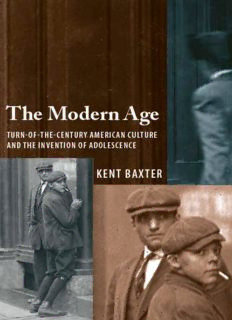
The Modern Age: Turn-of-the-Century American Culture and the Invention of Adolescence PDF
Preview The Modern Age: Turn-of-the-Century American Culture and the Invention of Adolescence
The Modern Age The Modern Age Turn- of- the- Century American Culture and the Invention of Adolescence Kent Baxter the university of alabama press Tuscaloosa Copyright © 2008 The University of Alabama Press Tuscaloosa, Alabama 35487-0380 All rights reserved Manufactured in the United States of America Typeface: Caslon ∞ The paper on which this book is printed meets the minimum requirements of American National Standard for Information S ciences- Permanence of Paper for Printed Library Materials, ANSI Z39.48-1984. ISBN 978-0-8173-5698-9 (pbk: alk. paper) A previous edition of this book has been catalogued by the Library of Congress. Library of Congress C ataloging- in- Publication Data Baxter, Kent. The modern age : turn- of- the- century American culture and the invention of adolescence / Kent Baxter. p. cm. Includes bibliographical references and index. ISBN 978-0-8173-1626-6 (cloth : alk. paper) — ISBN 978-0-8173-8074-8 (electronic) 1. Adolescence—U nited S tates—H istory—19th century. 2. Adolescence— United States— History—20th century. 3. Teenagers—U nited States— History— 19th century. 4. Teenagers—U nited States— History—20th century. 5. Teenagers— United States— Societies and c lubs— History—19th century. 6. Teenagers—U nited S tates— Societies and c lubs— History—20th century. 7. Alger, Horatio, 1832–1899— Fictional works. 8. Stratemeyer, Edward, 1862-1930—Fictional works. I. Title. HQ796.B3434 2008 305.2350973—dc22 2008010013 For Angela and Graeme Contents Acknowledgments ix Introduction 1 1. New Kids on the Block: School Reform, the Juvenile Court, and Demographic Change at the Turn of the Century 21 2. G. Stanley Hall, Margaret Mead, and the Invention of Adolescence 44 3. Every Vigorous Race: Age and Indian Reform Movements 73 4. Playing Indian: The Rise and Fall of the Woodcraft Youth Movements 93 5. Teen Reading at the Turn of the Century (Part I): Horatio Alger 116 6. Teen Reading at the Turn of the Century (Part II): Edward Stratemeyer 136 Notes 155 Selected Bibliography 175 Index 179 Acknowledgments Completing this book would never have been possible without the sup- port and encouragement of Jim Kincaid, whose brilliant insights into age categories and enthusiasm about this topic have both inspired and en- lightened my work in innumerable ways. Joseph Boone has been an in- credible mentor over the years; his thoughtful and patient guidance has helped me grow as both a writer and a scholar. Peggy Kamuf contributed greatly to this project in its early stages and, as a teacher, introduced me to ideas that continue to resonate in much of my work. I have the privilege of working with some wonderful colleagues in children’s and young adult literature at California State University, Northridge—C harles Hatfi eld, Dorothy Clark, and Jackie Stallcup— whose knowledge and creativity always extend my learning and challenge my ideas in new and interesting ways. Joseph Thomas has also been a great colleague and offered a good deal of intellectual and moral support with the research and publishing process. Scott Andrews generously provided assistance with my research on Indian boarding schools. Carol N ackenoff shared her extensive knowledge of Horatio Alger with me, providing sug- gestions for my analysis and advice on editions. Kimberly Embleton kindly helped out with the research of some of the more obscure texts. And my good friend Kevin Volkan gave some invaluable advice on the publishing process. Special thanks to the staff members at The University of Alabama Press, who have been incredibly responsive and professional in bringing this book to print. Part of the work for this project was completed under the auspices of a Research, Scholarship, and Creative Activity award and a College of Hu-
Description: